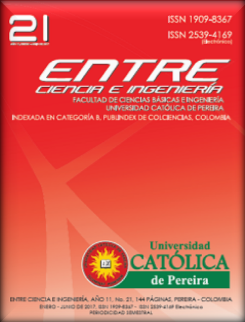Geometric redesign of a racing wheel skate chassis based on dynamic stresses and fatigue analysis.
DOI:
https://doi.org/10.31908/19098367.3285Keywords:
inline speed skating, double push technique, finite elements, redesign, stress analysis, fatigue analysisAbstract
through the years, speed skating has undergone several transformations, one of them has been the change in the size of the wheels and the variation of the technique used in competition, these changes aff ect the performance of athletes and it has generated changes in the forces applied to the frame skate. This has led to a lifetime reduction of the product, for this reason a study was done with a high performance athlete, a static and a dynamic study was performed about the loads over the skate frame. While the double-push technique is being executed by a professional skater roller, computational models were done for six types of current commercial frames, stress and fatigue safety factors were calculated, these values were used as a starting point for a geometric redesign which optimizes the stress distribution and increases the safety factor. It was possible to obtain a fi nal version of a light frame and an increase of 230 % on the fatigue safety factor.
References
J. J. de Koning, C. Foster, J. Lampen, F. Hettinga, and M. F. Bobbert, “Experimental evaluation of the power balance model of speed skating,” J. Appl. Physiol. Bethesda Md 1985, vol. 98, no. 1, pp. 227–233, Jan. 2005.
G. Suárez, Biomecánica deportiva aplicada, Primera Ed. Medellín: Funámbulos, 2011.
J. Acero, A. Palomino, H. Ibargüen, and C. Carmona, “Valoración cinemática (2d) sagital de la salida frontal de un patinador de carreras: un estudio piloto,” Inst. Investig. Soluciones Biomecánicas, 2003.
J. Egocheaga, J. Llavador, J. Díaz-Munío, M. Del Valle, O. Lekunberri, and I. Díaz, “Economía de carrera en el patinaje de velocidad. Influencia de la posición dentro del grupo,” Arch. Med. Deporte, vol. XXI, pp. 215–220, 2004.
K. García Londoño and M. Bolívar Moreno, “Comparación cinemática de los ciclos de empuje en patinadores competitivos, de 11 a 17 años, utilizando una tabla deslizante y la recta en pista,” Universidad tecnológica de Pereira, Pereira, 2011.
G. Suárez, Biomecánica deportiva y control del entrenamiento, Primera Ed. Medellín: Funámbulos, 2009.
C. Lugea, “Consideraciones sobre biomecánica en el patinaje,” SpeedSk8rs, 2011.
N. Petrone, “Acquisition and analyssis of ground reaction forces and foot orientation on in-line skates during track speed skating,” 2007.
T. J. Stidwill, R. A. Turcotte, P. Dixon, and D. J. Pearsall, “Force transducer system for measurement of ice hockey skating force,” Sports Eng., vol. 12, no. 2, pp. 63–68, Mar. 2009.
J. A. Villarraga Ossa, L. M. Bustamante Goez, and J. G. Diosa Peña, “Análisis Estático para Optimizar un Chasís de Patín de Carreras Sobre Ruedas,” vol. 10, no. 19, pp. 47–53, Jul. 2014.
“Lightworks: The professional editor for everyone.” [Online]. Available: https://www.lwks.com/. [Accessed: 02-Mar-2017].
“Kinovea.” [Online]. Available: https://www.kinovea.org/.[Accessed: 02-Mar-2017].
D. A. Winter, Biomechanics and Motor Control of Human Movement. John Wiley & Sons, 2009.
S. C. Chapra and R. P. Canale, Numerical methods for engineers, 6th ed., vol. 1. New York, NY: McGraw-Hill, 2010.
ANSYS, “Elements Reference.” ANSYS Inc.
R. Budynas and J. Keith, Diseño en Ingeniería Mecánica, 9th ed. McGraw-Hill, 2012.








 Revista Entre Ciencia e Ingeniería
Revista Entre Ciencia e Ingeniería .png) entrecei@ucp.edu.co
entrecei@ucp.edu.co.png) ISSN (Impreso) 1909-8367 - ISSN (En Línea) 2539-4169
ISSN (Impreso) 1909-8367 - ISSN (En Línea) 2539-4169 Attribution-NonCommercial 4.0 International (CC By-NC 4.0)
Attribution-NonCommercial 4.0 International (CC By-NC 4.0)
.png) Carrera 21 No. 49-95 Av. de las Américas, Pereira, Risaralda, Colombia
Carrera 21 No. 49-95 Av. de las Américas, Pereira, Risaralda, Colombia